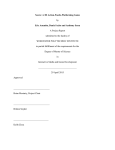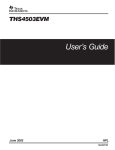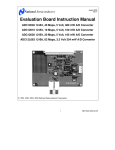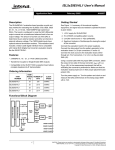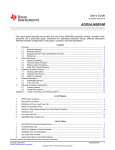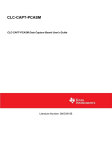Download National ADC12V170 User's Manual
Transcript
Evaluation Board User’s Guide for ADC12V170: 12-Bit, 170 MSPS Analog to Digital Converter with LVDS Outputs N www.national.com Rev 0.0 October 2007 ADC12V170 Evaluation Board User’s Guide Analog Input FIN > 150 MHz Analog Input FIN < 150 MHz Analog Input Network ADC PD Jumper Clock Buffer (Reverse Side) CLK_SEL/DF Jumper SingleEnded Clock Input FutureBus Connector 5.0V Power Connector Figure 1. ADC12V170 Evaluation Board Connector and Jumper Locations N -2- www.national.com Rev 0.0 ADC12V170 Evaluation Board User’s Guide 1.0 Introduction The ADC12V170 Evaluation Board is designed to support the ADC12V170 12-bit 170 Mega Sample Per Second (MSPS) Analog to Digital Converter with LVDS Outputs. The ADC12V170 Evaluation Board comes in two versions: 1. ADC12V170HFEB (high frequency version) for input frequencies greater than 150 MHz. 2. ADC12V170LFEB (low frequency version) for input frequencies less than 150 MHz. The digital data from the ADC12V170 evaluation board can be captured with a suitable instrument, such as a logic analyzer, or with National Semiconductor’s WaveVision signal path data acquisition hardware and software platform. The ADC12V170 evaluation board can be connected to the data acquisition hardware through the FutureBus connector (schematic reference designator FB). The ADC12V170 is compatible with National Semiconductor’s WaveVision 5.1 and higher Signal Path Digital Interface Board and associated WaveVision software. Please note that the ADC12V170 board is not compatible with previous versions of the WaveVision hardware (WaveVision 4.x Digital Interface Boards). The WaveVision hardware and software package allows fast and easy data acquisition and analysis. The WaveVision hardware connects to a host PC via a USB cable and is fully configured and controlled by the latest WaveVision software. The latest version of the WaveVision software is included in this evaluation kit on a CD-ROM. The WaveVision 5.1 Signal Path Digital Interface hardware is available through the National Semiconductor website (part number: WAVEVSN 5.1). 2.0 Board Assembly Each evaluation board from the factory is configured for single-ended clock operation and is populated with an analog input network which has been optimized for one of two analog input frequencies ranges: The location and description of the components on the ADC12V170 evaluation board can be found in Figure 1 as well as Section 5.0 (Schematic) and Section 7.0 (Bill of Materials) of this user’s guide. 3.0 Quick Start The ADC12V170 evaluation board enables easy set up for evaluating the performance of the ADC12V170. If the WaveVision data acquisition and data analysis system is to be used for capturing data, please follow the Quick Start Guide in the WaveVision User’s Guide to install the required software and to connect the WaveVision Digital Interface Board to the PC and to the ADC12V170 evaluation board. Please note that the ADC12V170 evaluation board is only compatible with National Semiconductor’s WaveVision 5.1 and higher Signal Path Digital Interface boards. 3.1 Evaluation Board Jumper Positions The ADC12V170 evaluation board jumpers should be configured as follows. Please refer to Figure 1 for the exact jumper locations. 1. J1 on the reverse of the board should be shorted. 2. The PD jumper places the ADC12V170 into either powerdown or sleep mode. Table 1 below shows how to select between the power modes. PD Jumper Setting Open 1-2 3-4 Mode Normal Operation Power-down Sleep Table 1. CLK_SEL/DF Selection Table 3. CLK_SEL/DF pin jumpers select the output data format (2’s complement or offset binary) and clock mode (single-ended or differential). Table 2 below shows how to select between the clock modes and output data formats. Please note that the ADC12V170 evaluation board is delivered with the ADC12V170 clock input configured for singleended operation and Offset Binary output data format (Jumper 7-8). CLK_SEL/DF Jumper Setting 1-2 3-4 5-6 7-8* 1. ADC12V170HFEB (high frequency version) for input frequencies greater than 150 MHz. 2. ADC12V170LFEB (low frequency version) for input frequencies less than 150 MHz. Clock Mode Output Data Format Differential Differential Single-Ended Single-Ended 2’s Complement Offset Binary 2’s Complement Offset Binary * As assembled from factory. Please refer to the input circuit configurations described in the Analog Input Section (4.2) of this guide. N Table 2. CLK_SEL/DF Selection Table -3- www.national.com Rev 0.0 ADC12V170 Evaluation Board User’s Guide 3.2 Connecting Power and Signal Sources 1. To power the ADC12V170 evaluation board, connect a 5.0V power supply capable of supplying up to 500mA to the green power connector labeled “+5V” which is located along the bottom edge of the ADC12V170 evaluation board. 2. Use the FutureBus connector (FB) to connect the ADC12V170 evaluation board to the instrument being used to capture the data from the evaluation board. If the WaveVision Digital Interface Board is being used for data capture, please consult the WaveVision User’s Guide for details on installing and operating the WaveVision hardware and software system. 3. Connect the clock and signal inputs to the CLK_IN_SE and AIN_XX (where XX = HF or LF) SMA connectors. 4.0 Functional Description 4.1 Clock Input The clock used to sample the analog input should be applied to the CLK_IN_SE SMA connector (if using the single-ended clock mode). To achieve the best noise performance (best SNR), a low jitter clock source with total additive jitter less than 150 fs should be used. A low jitter crystal oscillator is recommended, but a sinusoidal signal generator with low phase noise, such as the SMA100A from Rohde & Schwarz or the HP8644B (discontinued) from Agilent / Hewlett Packard, can also be used with a slight degradation in the noise performance. When using a low phase noise clock source, the SNR is primarily degraded by the broadband noise of the signal generator. The clock signal generator amplitude is typically set to +19.9 dBm to produce the highest possible slew rate, but the SNR performance will be impacted minimally by lowering the signal generator amplitude slightly. Placing a bandpass filter between the clock source and the CLK_IN_SE SMA connector will further improve the noise performance of the ADC N by filtering out the broadband noise of the clock source. All results in the ADC12V170 datasheet are obtained with a tunable bandpass filter made by Trilithic, Inc. in the clock signal path. The noise performance of the ADC12V170 can be improved further by making the edge transitions of the clock signal entering the ADC clock input (pin 11, CLK+) very sharp. The ADC12V170 evaluation board is assembled with a high speed buffer gate (NC7WV125K8X, schematic reference designator U2) in the clock input path to provide a sharp clock edge to the clock inputs and improve the noise performance of the ADC. The amplitude of the clock signal from the NC7WV125K8X high speed buffer is 3.3V. 4.2 Analog Input To obtain the best distortion results (best SFDR), the analog input network on the evaluation board must be optimized for the signal frequency being applied. For analog input frequencies up to 150 MHz, the circuit in Figure 2 is recommended. This is the configuration of the assembled ADC12V170LFEB as it is delivered from the factory. For input frequencies above 150 MHz, the circuit in Figure 3 is recommended. This is the configuration of the assembled ADC12V170HFEB as it is delivered from the factory. A low noise signal generator such as the HP8644B is recommended to drive the signal input of the ADC12V170 evaluation board. The output of the signal generator must be filtered to suppress the harmonic distortion produced by the signal generator and to allow accurate measurement of the ADC12V170 distortion performance. A low pass or a bandpass filter is recommended to filter the analog input signal. In some cases, a second low pass filter may be necessary. The bandpass filter on the analog input will further improve the noise performance of the ADC by filtering the broadband noise of the signal generator. Data shown in the ADC12V170 datasheet was taken with a tunable bandpass filter made by Trilithic in the analog signal path. -4- www.national.com Rev 0.0 ADC12V170 Evaluation Board User’s Guide Figure 2. Analog Input Network of ADC12V170LFEB: FIN < 150 MHz Figure 3. Analog Input Network of ADC12V170HFEB: FIN > 150 MHz 4.3 ADC Reference and Input Common Mode The internal 1.0V reference on the ADC12V170 is used to acquire all of the results in the ADC12V170 datasheet. It is recommended to use the internal reference on the ADC12V170. However, if an external reference is required, the ADC12V170 is capable of accepting an external reference voltage between 0.9V and 1.1V (1.0V recommended). The input impedance of the ADC12V170 VREF pin (pin 46) is 9 kΩ. Therefore, to overdrive this pin, the output impedance of the exernal reference source should be << 9 kΩ. It is recommended to use the voltage at the VRM pin (pin 45) of the ADC12V170 to provide the 1.5V common mode voltage required for the differential analog inputs VIN+ and VIN-. The ADC12V170 evaluation board is factory-assembled with VRM connected to the transformer center-tap through a N 49.9Ω resistor to provide the necessary common mode voltage to the differential analog input. 4.4 Board Outputs The digitized 12-bit output word from the ADC12V170 evaluation board is presented in interleaved double data rate (DDR) format. The digital output lines from the ADC12V170 evaluation board consist of 16 lines which are arranged into 8 LVDS pairs. These 8 pairs of lines carry the 12-bit output data (6 pairs), the DRDY signal which should be used to capture the output data (1 pair) and the over-range bit (OVR) which indicates that the digital output has exceeded the maximum digitizable signal (1 pair). Since the data is presented in interleaved double data rate (DDR) format, the 12-bit word is output on 6 data pair lines with half of the data (odd bits: D1+/-, D3+/-, -5- www.national.com Rev 0.0 ADC12V170 Evaluation Board User’s Guide …, D11+/-) being emitted with one clock edge during the first half of the clock period and the other half of the data (even bits: D0+/-, D2+/-, …, D10+/-) being emitted with the opposite clock edge during the second half of the clock period. The odd data bits should be captured with the falling edge of DRDY and the rising edge of DRDY should be used to capture the even bits of the data. DRDY signal which is used to capture the data is also in LVDS format and it is available at pins A4/D4 (DRDY+/-) on the FutureBus connector. The overrange bit (OVR) LVDS signal is available on pins D22/D21 (OVR+/-) on the FutureBus connector. The data is available on the evaluation board at pins A5/B5 (MSB +/-) through A10/B10 (LSB +/-) of the FutureBus connector (schematic reference designator FB). Please keep in mind that because the data is in DDR format, pins A5/B5 will carry data bit D11+/during the first half of the clock period and these lines will carry bit D10+/- during the second half of the clock period. Similarly, pins A10/B10 will carry D1+/- during the first half of the clock period and these pins will carry D0+/- during the second half of the clock period. The 4.5 Power requirements. N Please see the Evaluation Board schematic in Section 5.0 and the ADC12V170 datasheet for further details. Power to the ADC12V170 evaluation board is supplied through the green power connector labeled “+5V” which is located along the bottom edge of the board. Voltage and current requirements are: • +5V capable of providing up to 500mA (ADC12V170 evaluation board only) -6- www.national.com Rev 0.0 ADC12V170 Evaluation Board User’s Guide 5.0 Evaluation Board Schematic Figure 4. Signals N -7- www.national.com Rev 0.0 ADC12V170 Evaluation Board User’s Guide 5.0 Schematic (cont.) Figure 5. Power Distribution N -8- www.national.com Rev 0.0 ADC12V170 Evaluation Board User’s Guide 6.0 Evaluation Board Layout Figure 6. Layer 1 - Signal N -9- www.national.com Rev 0.0 ADC12V170 Evaluation Board User’s Guide 6.0 Evaluation Board Layout (cont.) Figure 7. Layer 2 - Ground N - 10 - www.national.com Rev 0.0 ADC12V170 Evaluation Board User’s Guide 6.0 Evaluation Board Layout (cont.) Figure 8. Layer 3 - Power N - 11 - www.national.com Rev 0.0 ADC12V170 Evaluation Board User’s Guide 6.0 Evaluation Board Layout (cont.) Figure 9. Layer 4 - Signal N - 12 - www.national.com Rev 0.0 Z1-3, Z6 R17, R19 R1-7, R12-13 R14-15 R26-27 R10, R24-25 AIN_HF, CLK_IN_SE sm/c_0201 sm/c_1206 Manufacturer Atmel National Semiconductor MA/COM AMP Panasonic - ECG Panasonic - ECG 0.1uF 0.1uF SMD CAP CERAMIC 10V X5R 10% sm/c_0402 Panasonic - ECG 0.01uF 0.01uF SMD CAP CERAMIC 16V X7R 10% sm/c_0402 AVX Corporation 10uF 2pF 1uF 10uF 10uF SMD CAP CERAMIC 10V X5R 20% 2pF SMD CAP CERAMIC 50v +/-0.25pF 1uF SMD CAP CERAMIC 25V X7R 10% 10uF SMD CAP TANTALUM 6.3V 20% sm/c_1206 sm/c_0402 sm/c_1206 sm/c_3216 Panasonic - ECG Murata Electronics Panasonic - ECG Kemet 2.2uF 68uF Ferrite Bead Core Jumper 1x8 Jumper 2X2 Jumper 2X4 Shunt 3.3V Regulator 1.8V Regulator Power Connector Terminal Block Power Connector Plug Bump-on Rubber Feet Tinylogic Buffer Kemet 2.2uF SMD CAP TANTALUM 16V 10% sm/c_3216 Kemet 68uF SMD CAP TANTALUM 6.3V 10% sm/c_7343 Panasonic -ECG SMD FERRITE BEAD CORE 4.5X3.2X1.8 Samtec JUMPER BLOCK USING 8 PIN SIP HEADER Samtec 2X2 JUMPER BLOCK HEADER CUT TO SIZE FROM 2X6 HEADER Samtec 2X4 JUMPER BLOCK HEADER CUT TO SIZE FROM 2X6 HEADER FCI Electronic PLACE SHUNT ACROSS PINS 7-8 ON CLK_SEL/DF JUMPER National Semiconductor 1A LOW DROPOUT REGULATOR FOR 5V TO 3.3 V CONVERSION SOT-223 MICROPOWER/LOW NOISE, 500 mA ULTRA LOW-DROPOUT REGULATOR SOIC NARROW -8 National Semiconductor Phoenix Contact TERMINAL BLOCK 2POS 5.08mm Phoenix Contact TERMINAL BLOCK PLUG 2POS 5.08mm 3M PLACE BUMP ONS AT THE 4 CORNERS, ON BOTTOM OF BOARD Fairchild Semiconductor TINYLOGIC ULP-A BUFFER WITH 3-STATE OUTPUT 8-LEAD US8, JEDEC MO-187, CA 3.1 mm WIDE Murata Electronics FILTER LC HIGH FREQ .2UF 1806 Vishay Dale 0 OHM SMD RESISTOR sm/r_0402 Panasonic - ECG 1 kOHM SMD RESISTOR 1/16W 1% sm/r_0402 Yageo Corporation 24.9 OHM SMD RESISTOR 1/16W 1% sm/r_0402 Vishay Dale 33.2 OHM SMD RESISTOR 1/16W 1% sm/r_0402 Yageo Corporation 49.9 OHM SMD RESISTOR 1/16W 1% sm/r_0402 Emerson Network Power Connectivity PCB MOUNTABLE SMA CONNECTOR - Noise Suppression Filter 0 ohms 1 kOHM 24.9 ohms 33.2 ohms 49.9 ohms SMA Input PCB Footprint SOIC-8 48-LLP www.national.com Rev 0.0 ADC12V170 Evaluation Board User’s Guide 4 2 9 2 2 3 2 Description 2K SERIAL EEPROM 1.8V 12-Bit, 170 MSPS Analog/Digital Converter with LVDS Outputs BALUN TRANSFORMER Z-PACK 2mm FB (Futurebus+) RIGHT ANGLE HEADER CONNECTOR 0.1uF SMD CAP CERAMIC 6.3V X5R 10% 0.1uF SMD CAP CERAMIC 25V X7R 10% 7.0 Evaluation Board Bill of Materials - 13 - 26 27 28 29 30 31 32 Part Name 24C02 ADC12V170 ETC1-1-13 AMP_5223514-1 0.1uF 0.1uF 7.1 ADC12V170HFEB (For Fin > 150 MHz) N Item Quantity Schematic Reference 1 1 U6 2 1 ADC 3 2 T6, T10 4 4 FB 5 1 C75 6 6 C2, C14, C20, C22, C24, C66 7 21 C9, C15 C26, C27, C29, C31, C33, C35, C37, C39, C41, C43, C45, C47, C49-51, C53, C59, C71, C72 8 12 C10, C12, C28, C30, C32, C34, C36, C38, C40, C42 C44, C46 9 1 C13 10 1 C74 11 2 C4, C6 12 9 C1, C3, C8, C19, C21, C23, C48, C52, C54 13 1 C11 14 1 C5 15 2 L1, L2 16 1 JTAG 17 1 PD 18 1 CLK_SEL/DF 19 1 20 1 U1 21 1 U3 22 1 +5V 23 1 24 4 MT1-4 25 1 U2 Z1-3, Z6 R17, R19 R1-7, R12-13 R14-15, R24-25 R26-27 R10 AIN_LF, CLK_IN_SE PCB Footprint SOIC-8 48-LLP CD542 sm/c_0201 sm/c_1206 Manufacturer Atmel National Semiconductor MINI CIRCUITS AMP Panasonic - ECG Panasonic - ECG 0.1uF 0.1uF SMD CAP CERAMIC 10V X5R 10% sm/c_0402 Panasonic - ECG 0.01uF 0.01uF SMD CAP CERAMIC 16V X7R 10% sm/c_0402 AVX Corporation 10uF 15pF 1uF 10uF 10uF SMD CAP CERAMIC 10V X5R 20% 15pF SMD CAP CERAMIC 50v NP0 5% 1uF SMD CAP CERAMIC 25V X7R 10% 10uF SMD CAP TANTALUM 6.3V 20% sm/c_1206 sm/c_0402 sm/c_1206 sm/c_3216 Panasonic - ECG Panasonic - ECG Panasonic - ECG Kemet 2.2uF 68uF Ferrite Bead Core Jumper 1x8 Jumper 2X2 Jumper 2X4 Shunt 3.3V Regulator 1.8V Regulator Power Connector Terminal Block Power Connector Plug Bump-on Rubber Feet Tinylogic Buffer Kemet 2.2uF SMD CAP TANTALUM 16V 10% sm/c_3216 Kemet 68uF SMD CAP TANTALUM 6.3V 10% sm/c_7343 Panasonic -ECG SMD FERRITE BEAD CORE 4.5X3.2X1.8 Samtec JUMPER BLOCK USING 8 PIN SIP HEADER Samtec 2X2 JUMPER BLOCK HEADER CUT TO SIZE FROM 2X6 HEADER Samtec 2X4 JUMPER BLOCK HEADER CUT TO SIZE FROM 2X6 HEADER FCI Electronic PLACE SHUNT ACROSS PINS 7-8 ON CLK_SEL/DF JUMPER National Semiconductor 1A LOW DROPOUT REGULATOR FOR 5V TO 3.3 V CONVERSION SOT-223 MICROPOWER/LOW NOISE, 500 mA ULTRA LOW-DROPOUT REGULATOR SOIC NARROW -8 National Semiconductor Phoenix Contact TERMINAL BLOCK 2POS 5.08mm Phoenix Contact TERMINAL BLOCK PLUG 2POS 5.08mm 3M PLACE BUMP ONS AT THE 4 CORNERS, ON BOTTOM OF BOARD Fairchild Semiconductor TINYLOGIC ULP-A BUFFER WITH 3-STATE OUTPUT 8-LEAD US8, JEDEC MO-187, CA 3.1 mm WIDE Murata Electronics FILTER LC HIGH FREQ .2UF 1806 Vishay Dale 0 OHM SMD RESISTOR sm/r_0402 Panasonic - ECG 1 kOHM SMD RESISTOR 1/16W 1% sm/r_0402 Yageo Corporation 24.9 OHM SMD RESISTOR 1/16W 1% sm/r_0402 Vishay Dale 33.2 OHM SMD RESISTOR 1/16W 1% sm/r_0402 Yageo Corporation 49.9 OHM SMD RESISTOR 1/16W 1% sm/r_0402 Emerson Network Power Connectivity PCB MOUNTABLE SMA CONNECTOR - Noise Suppression Filter 0 ohms 1 kOHM 24.9 ohms 33.2 ohms 49.9 ohms SMA Input www.national.com Rev 0.0 ADC12V170 Evaluation Board User’s Guide 4 2 9 4 2 1 2 Description 2K SERIAL EEPROM 1.8V 12-Bit, 170 MSPS Analog/Digital Converter with LVDS Outputs WIDEBAND RF TRANSFORMER 0.4MHz - 800 MHz Z-PACK 2mm FB (Futurebus+) RIGHT ANGLE HEADER CONNECTOR 0.1uF SMD CAP CERAMIC 6.3V X5R 10% 0.1uF SMD CAP CERAMIC 25V X7R 10% 7.0 Evaluation Board Bill of Materials (cont.) - 14 - 26 27 28 29 30 31 32 Part Name 24C02 ADC12V170 ADT1-1WT+ AMP_5223514-1 0.1uF 0.1uF 7.2 ADC12V170LFEB (For Fin < 150 MHz) N Item Quantity Schematic Reference 1 1 U6 2 1 ADC 3 1 T7 4 4 FB 5 1 C75 6 6 C2, C14, C20, C22, C24, C66 7 21 C9, C15 C26, C27, C29, C31, C33, C35, C37, C39, C41, C43, C45, C47, C49-51, C53, C59, C71, C72 8 12 C10, C12, C28, C30, C32, C34, C36, C38, C40, C42 C44, C46 9 1 C13 10 3 C74, C78-79 11 2 C4, C6 12 9 C1, C3, C8, C19, C21, C23, C48, C52, C54 13 1 C11 14 1 C5 15 2 L1, L2 16 1 JTAG 17 1 PD 18 1 CLK_SEL/DF 19 1 20 1 U1 21 1 U3 22 1 +5V 23 1 24 4 MT1-4 25 1 U2 ADC12V170 Evaluation Board User’s Guide The ADC12V170 Evaluation Board is intended for product evaluation purposes only and is not intended for resale to end consumers, is not authorized for such use and is not designed for compliance with European EMC Directive 89/336/EEC. WaveVision is a trademark of National Semiconductor Corporation. National does not assume any responsibility for use of any circuitry or software supplied or described. No circuit patent licenses are implied. LIFE SUPPORT POLICY NATIONAL'S PRODUCTS ARE NOT AUTHORIZED FOR USE AS CRITICAL COMPONENTS IN LIFE SUPPORT DEVICES OR SYSTEMS WITHOUT THE EXPRESS WRITTEN APPROVAL OF THE PRESIDENT OF NATIONAL SEMICONDUCTOR CORPORATION. As used herein: 1. Life support devices or systems are devices or systems which, (a) are intended for surgical implant into the body, or (b) support or sustain life, and whose failure to perform, when properly used in accordance with instructions for use provided in the labeling, can be reasonably expected to result in a significant injury to the user. 2. A critical component is any component in a life support device or system whose failure to perform can be reasonably expected to cause the failure of the life support device or system, or to affect its safety or effectiveness. N National Semiconductor Corporation Americas Tel: 1-800-272-9959 Fax: 1-800-737-7018 Email: [email protected] National Semiconductor Europe Fax: +49 (0) 1 80-530 85 86 Email: [email protected] Deutsch Tel: +49 (0) 1 80-530 85 85 English Tel: +49 (0) 1 80 532 78 32 National Semiconductor Asia Pacific Customer Response Group Tel: 65-2544466 Fax: 65-2504466 Email: [email protected] National Semiconductor Japan Ltd. Tel: 81-3-5639-7560 Fax: 81-3-5639-7507 National does not assume any responsibility for any circuitry described, no circuit patent licenses are implied and National reserves the right at any time without notice to change said circuitry and specifications. N - 15 - www.national.com Rev 0.0


















